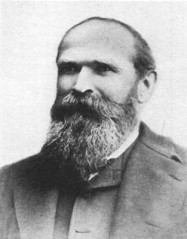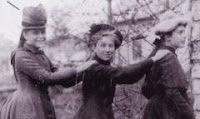If the above topic sounds like a "nerd alert," relax. Think family history of a few of the Native American tribes who live along the Mississippi and Missouri Rivers.
 |
| 1852 Omaha delegation to Washington D.C. |
When I learn of a tribe who lived in the general region where I have set one of my stories, I always like to find out a little bit of their history. What drove me to learn more about something that sounds complicated is that in my latest book, released today, a big part of the setting is in Omaha, Nebraska. The city, Omaha, is named after the Omaha tribe. All right, so who are the Omaha tribe, where did they come from, and where were they in 1873, the year my story takes place?
 |
| Lower Ohio River Valley from 1653 Map |
One of the first things I learned were that the Omaha people were one of five related tribes, all who share a language group called Siouan. (Yes, that is as in Sioux. They are also a Siouan tribe, one I might feature in a future blog post.) Technically, these tribes are known as the Dhegiha-Siouan division of the Hopewell cultures of the lower Ohio Valley. That is roughly along the lower Ohio River region, the part that is closer to the Mississippi River. At one time, they lived together as one tribe. However, as they grew, in order to hunt and gather enough food to feed their families, bands or groups began breaking off and became separate tirbes.
As I began to research the roots of the Omaha tribe, I learned I already wrote about, and put together several blog posts on another tribe that belongs to this same group, the Kaw, or Kansa, tribe, which you may find HERE, HERE, HERE, HERE, and HERE.
 |
| The pink surrounding Lake Michigan show Siouan language region |
The other three tribes which belong to this same language group are the Osage (which were closely tied with the Kaw, often through frequent intermarriage), the Quapaw, and the Ponca. The Ponca was originally a band of the Omaha. In about the 1700s, it broke off and established itself as a separate tribe.
These five tribes are all were part of what linguists call the Western Siouan language group, which is closely realted to the Catawban language group, often called the Eastern Siouan language group.
At one time, all five of these tribes lived together in what is known as the Eastern Woodlands part of North America. However, several centuries ago, they began to be pushed west by tribes who also were pushed west due to European arrival on the East coast. It is estimated that in their earlier history, they might have lived in what today are the states of North Carolina, Virginia, and Ohio. From there, these five tribes moved down the Mississippi River. A few of them moved up the Missouri River.
Here is where they ended up in the 1800s.
 |
| Arkansas map showing land treaties with Quapaws |
 |
| Quapaw Robe |
The Quapaw traveled with the Omaha down the Mississippi River. However, they continued past the mouth of the Missouri River and settled near the confluence of the Arkansas and Mississippi Rivers. Among the other tribes in this language group, they became known as the “Downriver People.”
The Kaws and Osages traveled up the Missouri River. The Kaw settled near the mouth of the Kansas River, which was named for the tribe. Originally, it held territory on both sides of the Missouri River until persuaded through treaty to give up their territory east of the river and settle only on the west. They became known as the “People of the South Wind,” due to their position in tribal war ceremonies.
 |
| Osage Chief Black Dog by George Catlin |
The Osage tribe settled to the south of the Kaws. The Osage tribe became known as the “people of the middle waters.”
The Kaws were originally assigned to a reservation at Council Grove along the Santa Fe Trail before the Kansas –Nebraska Act of 1854 opened up land in those two territories for white settlement. As the tribe weakened due to disease, like their neighboring tribe, the Osages, they were moved to reservations in Indian Territory, now part of Oklahoma.
As for the Omaha tribe, they continued north up the Missouri
River, which resulted in them becoming known as the “Upstream People,” or “going
against the current.” They held a great deal of territory until treaties forced upon them whittled it down to what it is today.
 |
| Chief Standing Bear - Ponca |
The Ponca tribe, formerly a band of the Omaha, broke off and moved to the territory northwest of Omaha territory. They derived their name from “Those Who Lead.” The tribe had a time of it when the United States decided to remove it from its lands in Nebraska. At first, they put them on the same reservation with the Sioux, which caused continual conflict, since they considered each other enemies. When told they must go to Indian Territory in what is now Oklahoma, they refused, referring to an earlier 1851 Fort Laramie treaty. The government forced them to move, which resulted in multiple deaths due to malaria, food shortages, and excessive heat. Later, about half of the tribe returned to their ancestral lands in Nebraska.
Each tribe has an extensive and interesting history worthy of several book-length works. This overview was designed as an short “family history” summary to show how these five tribes had common roots—both in ancestral lands and language similarities.
 |
| Omaha by George Catlin |
For my book, Bee Sting Cake by Brunhilde, I wrote two chapters about the Omaha tribe and their reservation in Northeastern Nebraska. At the eleventh hour—as in, I delayed getting my manuscript to my editor for a day—I took them out. I enjoyed researching and writing them, but felt they did not add to the main theme of the story. Some readers might find them interesting. Most editors would have called them an “info dump.” I might end up sharing them in a blog post—an “ended up on the cutting room floor” feature. Either way, I enjoyed learning more about the Omaha tribe, their history, and the challenges they faced in the mid and late 1800s.
Bee Sting Cake by Brunhilde was released today and is now available. It is in ebook format and available on Kindle Unlimited. I plan to have the paperback version available soon.
You may find the book description and purchase options by CLICKING HERE.


_language_map_01%20300dpi.png)




















.png)




















